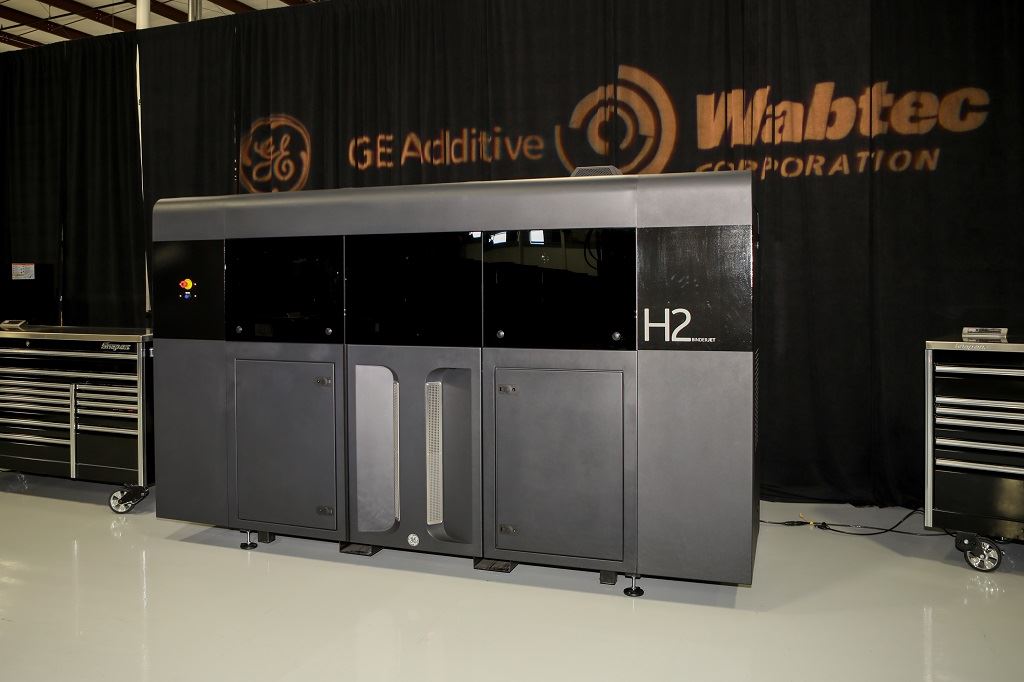![[Image: GE Additive]](https://fabbaloo.com/wp-content/uploads/2020/05/WabtecandGEAdditive_BinderJet-GEAdditiveH2betamachine_img_5eb09782c5c05.jpg)
GE Additive’s H2 binder jetting system has found another home with Wabtec.
Just a month after announcing an early customer investment with Cummins, GE’s binder jetting offering is seeing another notable installation.
Pennsylvania-based Wabtec is focused on the freight and transit rail industry, offering equipment, systems, digital solutions, and services. The transit portfolio is expanding now with what it calls a “first-of-its-kind order” to accelerate the company’s “growing additive strategy.”
Wabtec has been working closely with GE Transportation, and now the deal with GE Additive continues to advance the focus on advanced technology offerings. GE Transportation, for its part, has also been working to bring additive manufacturing more deeply into its offerings, announcing intent to 3D print hundreds of locomotive parts by 2025.
The rail industry in general has been among those embracing additive manufacturing, addressing obsolescence and supply chain considerations with the technology.
Wabtec has already identified use cases for as many as 250 components in its product lines that can be addressed with additive manufacturing.
“Additive is one of the key technology pillars for our company and central in our efforts to drive innovation in the industries we serve. This binder jet machine will help us design and produce reliable, low-cost components for our current and developmental engines, locomotive, transit and mining programs,” said Philip Moslener, Global Director of the WabtecOne Platform & Applied Innovation.
As we saw with Cummins, the H2 investment is one made through a close relationship with GE Additive. So close, indeed, that again the H2 machine is currently housed in Cincinnati, where the Wabtec team is co-located to work with the GE Additive lab on technology development. The system will make its way to Wabtec’s facility in Grove City, Pennsylvania before the end of this year.
Again, a key word jumps out of the announcement — which includes the note that “Wabtec already received its first H2 machine” — first.
While terms were not disclosed, we again see that the investment isn’t just for a single system, but multiple.
These cases of early adopters bringing in two or more H2 binder jetting machines to operations, following initial close work alongside the GE Additive team, show dedication to ensuring all is in place for scalable installations once the systems are ready for commercial availability. Currently that’s estimated for early 2021.
“Throughout 2018, a multi-disciplinary team at GE Additive developed the second generation ‘H2’ binder jet beta machines. Today, parts are being printed on those machines, which we understand provide the largest format and fastest build speed currently on the market,” said Josh Mook, Innovation Leader at GE Additive.
“Fast forward to early 2019 and we launched the H2 beta testing and partner program. We deliberately sought out partners and key customers, like Wabtec, who are committed to mass production, but also known and respected for their commitment to the early adoption of innovation. Most importantly we want to partner with customers whose businesses will benefit tremendously from Binder Jet’s ability to reliably print large, complex parts at high throughput and low cost,” added Mook.
Via Wabtec and GE Additive









